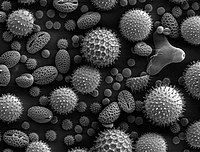
Photo from wikipedia
While dynamic surface topographies are fabricated using liquid crystal (LC) polymers, switching between two distinct 3D topographies remains challenging. In this work, two switchable 3D surface topographies are created in… Click to show full abstract
While dynamic surface topographies are fabricated using liquid crystal (LC) polymers, switching between two distinct 3D topographies remains challenging. In this work, two switchable 3D surface topographies are created in LC elastomer (LCE) coatings using a two-step imprint lithography process. A first imprinting creates a surface microstructure on the LCE coating which is polymerized by a base catalyzed partial thiol-acrylate crosslinking step. The structured coating is then imprinted with a second mold to program the second topography, which is subsequently fully polymerized by light. The resulting LCE coatings display reversible surface switching between the two programmed 3D states. By varying the molds used during the two imprinting steps, diverse dynamic topographies can be achieved. For example, by using grating and rough molds sequentially, switchable surface topographies between a random scatterer and an ordered diffractor are achieved. Additionally, by using negative and positive triangular prism molds consecutively, dynamic surface topographies switching between two 3D structural states are achieved, driven by differential order/disorder transitions in the different areas of the film. It is anticipated that this platform of dynamic 3D topological switching can be used for many applications, including antifouling and biomedical surfaces, switchable friction elements, tunable optics, and beyond.
Journal Title: Small
Year Published: 2023
Link to full text (if available)
Share on Social Media: Sign Up to like & get
recommendations!